Backlogs come in all shapes and sizes. Organizing your work into various backlogs can help bring clarity and focus.
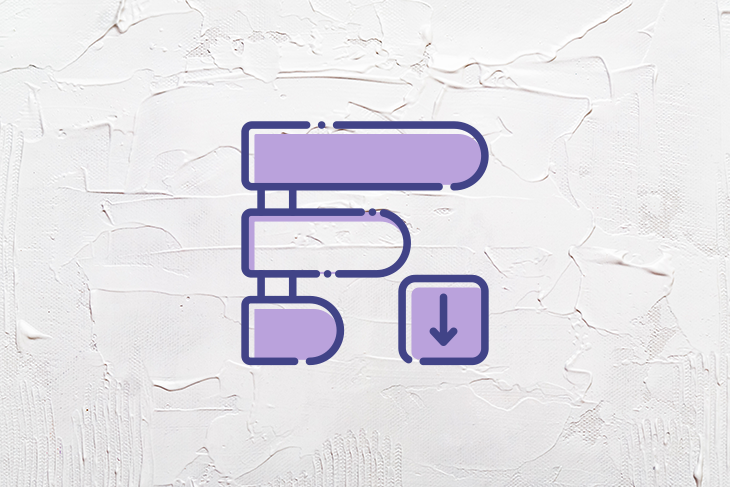
For example, scrum utilizes two backlogs: the product backlog and the sprint backlog. While the product backlog provides clarity on all the work for the product team, the sprint backlog focuses on what the team is working on during the current sprint.
It’s also common for product teams to have a third backlog, known as the release backlog, which contains all the work required for a particular release.
In this guide, we’ll highlight the differences between the product backlog vs. sprint backlog vs. release backlog and demonstrate how you can leverage them in tandem to manage your product more effectively.
A backlog is a list of things you must, should, could, or would like to do. A simple example of a backlog is a to-do list.
In agile teams, we work from a common backlog, often referred to as the product backlog. This is the master list of all the potential product improvements, opportunities, and new ideas we would like to pursue.
For example, a product backlog might include new features, infrastructure improvements, UI enhancements, technical debt, new market opportunities, etc.
The intent behind a backlog is to create a single source of truth for the priority of work the product team plans to complete during a given period of time.
A backlog is a living document, meaning that it’s constantly updated. Product teams will update the backlog accordingly as they gain a better understanding and uncover new information. This may result in adding new backlog items, removing items, updating the priority of backlog items, or even further refining an item to go into greater detail.
The product backlog, as described in The Scrum Guide, is the master list of all work necessary to improve the product. It is the single source of work for the scrum team.
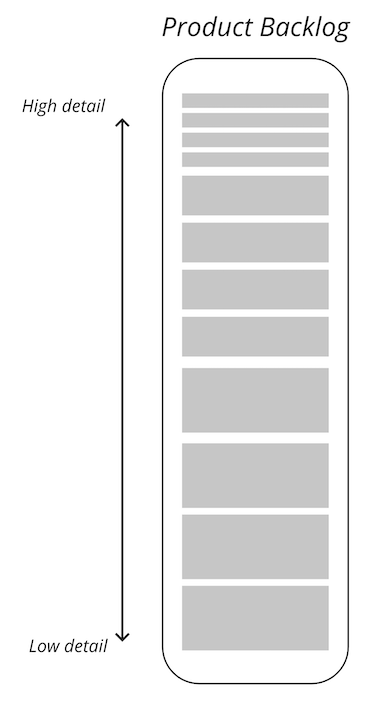
A product backlog is an ordered list; items should be ordered according to priority, with the items at the top having the highest priority and the items at the bottom representing the lowest.
The product manager is responsible for managing the product backlog. They set the priority and ensure that the product backlog is up to date.
The product backlog must be groomed and emergent, with items added, removed, and refined regularly.
A healthy backlog is never too large. That said, it’s important to ensure the backlog doesn’t become a dumping ground and that no-longer-relevant items are regularly removed.
Common items that you would find on a product backlog include:
Remember, there’s no guarantee that all items in the product backlog will be done. Agile teams take a just-in-time approach to the product backlog where items toward the top (highest priority) have a more granular level of detail. Conversely, the items toward the bottom tend to be less detailed and are often represented as a one-line description.
The farther a backlog items projects into the future, the more likely they are to be removed, altered, or changed based on new information, market changes, customer feedback, etc. Therefore we want to minimize the time invested into refining these items where possible.
Whereas the product backlog details all the work for the product, the release backlog is a subset of that product backlog and focuses on the work required for a release.
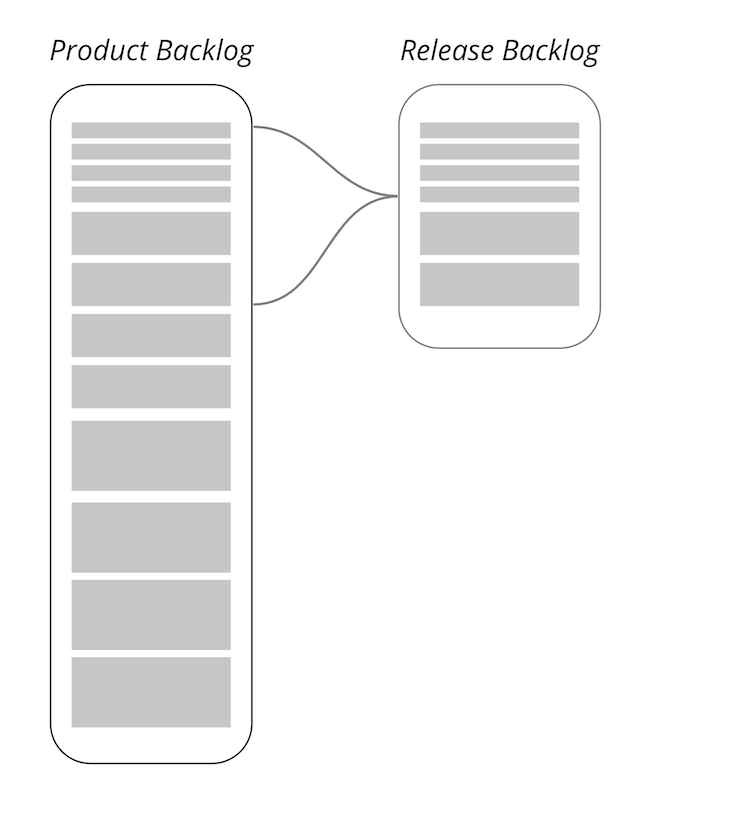
Typically containing at least one significant feature or improvement, the release backlog enables the product team and stakeholders to focus on what work is necessary to complete for a given release.
Like the product backlog, the release backlog is emergent. New work or functionality may emerge as we work toward a release that must be included. We may also learn and adapt to new information and remove things from the release backlog, either putting them back into the product backlog for a future release or removing them altogether.
You may choose to have more than one release backlog representing the next and one or two future releases. However, it’s best not to plan too far into the future.
The sprint backlog, as described in The Scrum Guide, is a subset of the product backlog. It is an actionable plan for delivering a product increment during the associated sprint.
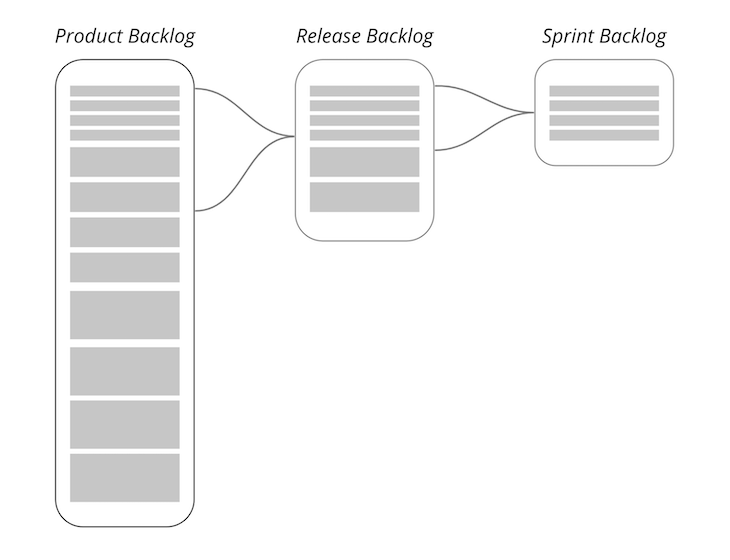
Sprints are time-boxed iterations in which product teams often work to deliver incremental value to their customers. Typically lasting 2–4 weeks, the product team decides what it can deliver from the product backlog in that time to achieve the sprint goal. This work forms what is known as the sprint backlog.
Where the product backlog looks across all time horizons from near to long term, the sprint backlog is focused on the near-term — the current sprint.
The sprint backlog is created during sprint planning, where the team decides what to take into the current sprint from the product backlog and determines how the team intends to deliver it.
During the sprint, the product team works from the sprint backlog. It provides focus to the team so they aren’t distracted by other backlog items in the product or release backlog, and it gives clarity to the team on what is required to be completed in the current sprint.
Like the product and release backlogs, the sprint backlog is emergent. The sprint backlog can change during the sprint if necessary to achieve the sprint goal.
The team refines the sprint backlog each day during the daily scrum, where participants discuss progress, changes, and impediments to the sprint. While the product manager is responsible for the product backlog, and the team is responsible for the sprint backlog.
The following table highlights key differences between the product backlog, sprint backlog, and release backlog.
| Product backlog | Sprint backlog | Release backlog | |
|---|---|---|---|
| Purpose | Master list of all work for advancing the product | Work to be completed in the current sprint | Master list of all work needed to complete for a given release |
| Owner | Product manager/owner | Product/development team | Product manager/owner (in some cases, tech lead, delivery manager or technical project manager) |
| Commitment | Product goal | Sprint goal | Release goal |
| Work items | Epics and opportunities | User stories and tasks | Features and user stories |
| Duration | Indefinitely into the future | 2–4 weeks | Next release (e.g., next 1–3 months) |
| Estimation technique | T-shirt sizing | Story points/hours | Story points |
| Refinement technique | Product backlog refinement | Sprint planning | Release planning |
| Reporting | Product roadmap | Sprint burndown | Release burndown |
A key responsibility of the product manager is to maintain the product backlog. Often referred to as backlog grooming or refinement, this is the act of ordering items, breaking items down, removing redundant items, and adding in necessary details.
Although there is no official backlog refinement event, agile teams often find it helpful to set aside time to review the backlog together. To refine the backlog effectively, product managers and teams need to thoroughly understand their customers, business, and market.
They do this not by being domain experts but by investing time to speak with customers, analyzing the market and competitors, and drawing insights from data on user behaviors. As a result, backlog refinement is much more about what is known as product discovery than ordering and updating items on a backlog.
Product discovery is the process of building a deeper understanding of your users, customers, and market. Drawing from design thinking practices, product discovery is about uncovering user needs, customer problems, and underserved market opportunities. By doing so, we can effectively inform what should be in the product backlog and in what order.
While the product manager is responsible for the backlog, they may delegate and collaborate with various team members and stakeholders to refine the backlog. For example, engineers may be best equipped to refine technical debt items in the backlog, designers are best suited to update the backlog based on UI enhancements, etc.
Furthermore, a product backlog should align to a product goal, which the product strategy should inform. To effectively manage a product backlog, you must first have a product goal at the bare minimum.
When refining the backlog, you should:
You should not:
There are myriad ways to structure your product, release, and sprint backlogs. In many cases, depending on what tool you use, it may be advantageous to either tag or organize your backlog in a certain way. For example, tools like Jira enable you assign backlog items to a release and a sprint.
However, if you’re looking for inspiration, there are other structures that can be very powerful for organizing work into the backlogs described above.
User story maps are excellent for initial backlog creation, but they can also be really powerful to help organize work into releases and even sprints.
A user story map outlines a typical user journey and breaks down the tasks and user stories that make each step possible.
From there, we can divide the user stories and categorize them into buckets, such as releases or sprints.
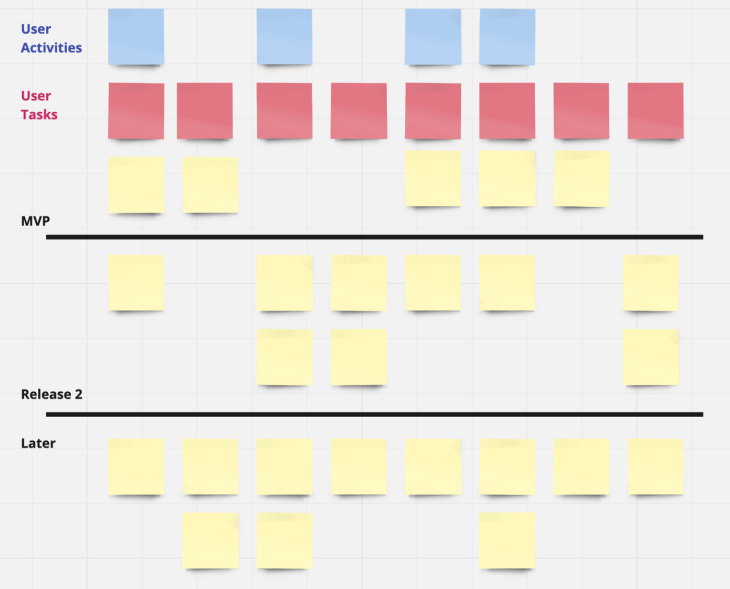
The funnel backlog is a fantastic way to visualize and organize your backlogs. It’s comprised of the product backlog on the left, split into one or more release backlogs, and, finally, the sprint backlog on the right.
Work flows down the funnel from the product backlog into a release backlog and then, finally, into your sprint.
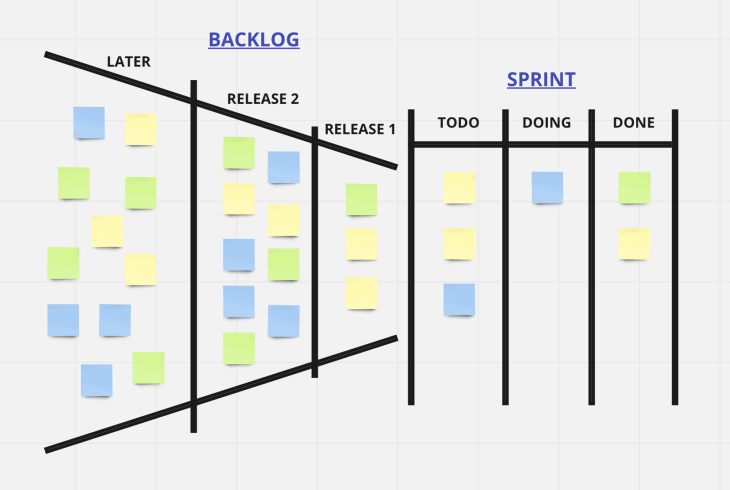
As the name suggests, an opportunity backlog is a list of opportunities you wish to explore further.
This approach is popular with product managers who work in what is referred to as a dual-track approach.
In dual-track agile development, you split your work into two streams: delivery and discovery.

An opportunity backlog is your discovery backlog. All problem spaces and opportunities on which you see fit to spend time doing discovery are put into this backlog. It is then refined and prioritized like any other backlog.
The key difference here is that work typically flows from your opportunity backlog to either your product backlog or release backlog, where they will then move through the typical delivery cycle.
This is a great way to organize your work. As mentioned earlier, a good backlog is informed by discovery and customer research. By having an opportunity backlog, we ensure that we are doing that — checking our assumptions and spending time with our customers to validate problem spaces and opportunities regularly.
Featured image source: IconScout

LogRocket identifies friction points in the user experience so you can make informed decisions about product and design changes that must happen to hit your goals.
With LogRocket, you can understand the scope of the issues affecting your product and prioritize the changes that need to be made. LogRocket simplifies workflows by allowing Engineering, Product, UX, and Design teams to work from the same data as you, eliminating any confusion about what needs to be done.
Get your teams on the same page — try LogRocket today.

A practical framework for PMs to use AI in ideation without sacrificing judgment, strategy, or decision quality.

A practical five minute revenue estimation method to help product managers compare ideas, drop low impact features, and prioritize smarter.

A practical guide for PMs who want to stop being bottlenecks, delegate smarter, and lead teams effectively with a clear ownership framework.

Stop letting unreliable data block features. Treat data as inventory to track quality, ownership, and ship with confidence.